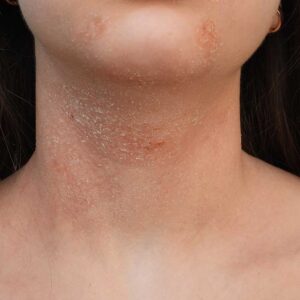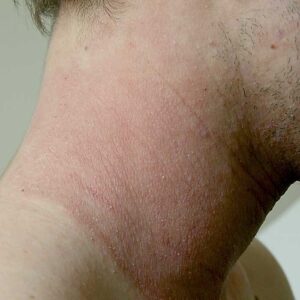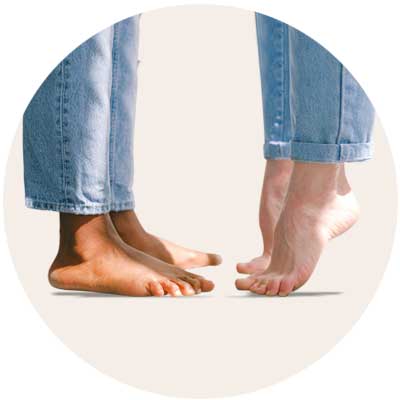Facial Atopic Dermatitis: symptoms, causes and treatment
Facial Atopic Dermatitis, also known as Facial Atopic Eczema, is a chronic, recurrent, inflammatory, skin disease. Itching is the main symptom with skin lesions ranging from mild erythema to erythroderma.
What are the main symptoms of Atopic Dermatitis?
The main symptom of facial atopic dermatitis or facial atopic eczema is definitely itching, which is intense and persistent, often present even in the absence of skin lesions. Itching also causes possible bacterial infections. Other symptoms that can occur in the process of this form of eczema are varying degrees of skin lesions.
The most affected sites are on the face, around the mouth and cheeks and around the eyes, also including the eyelids, in which case it is called Eyelid Dermatitis
At what age does Atopic Dermatitis occur?
Atopic dermatitis can affect individuals of any age, from children to adults.
Atopic dermatitis in infants and children
Infants and children are certainly the most affected. It manifests itself, mainly, around 2-4 months of age or between 6 and 8 years. The face is the part most affected in this age group.
Atopic dermatitis in adults
Although it is more common in children, atopic dermatitis also affects people in adulthood and can occur even in people over 60 years of age.
What causes Atopic Dermatitis?
The cause of Atopic Dermatitis is a strong genetic predisposition due to familiarity.
But there are many other factors:
- Change of season
- Damp environment
- Lack of exposure to the sun
- Contact with environmental dust
- Contact with animal dander
- Over-frequent washing
- Physical fatigue
- Mental fatigue, emotional stress (Stress Dermatitis)
- Intercurrent illnesses, drug-use, etc.
Predisposition
People with facial atopic dermatitis are predisposed to other reactive forms such as pollinosis (atopic rhinitis) and atopic bronchial asthma. They can become sensitised to nickel. Acute adverse drug reactions may occur. They are prone to developing infectious, bacterial or viral skin diseases (herpes, warts or contagious mollusca).


What are the treatments for Facial Atopic Dermatitis?
There is no standard cure for Atopic Dermatitis or Atopic Eczema, so it is important to eliminate the concomitant factors, if possible, with preventive action. In short, to treat the dermatitis symptoms..
Treatment
Conventional washing must be strictly avoided because water is known to be the main enemy of the skin in cases of Atopic Dermatitis.
Which cream to use to soothe Atopic Dermatitis?
To alleviate the skin manifestations related to Atopic Dermatitis, we recommend specific treatments depending on the symptoms:
Apply Crema Lenitiva every evening. It is a cream with zinc oxide and magnesium silicate with astringent and anti-itching action, and is also able to absorb moisture. Ideal in frequent cases of mild reddening of the skin on the face.
Apply Dermictiol Cream in the evening and massage well. Dermictiol Cream contains ichthyol sulfonate, an anti-inflammatory and anti-itching agent of mineral origin. Do not apply to eyelids and eye area.
Massage PEG Ointment into the affected areas until absorbed. Apply every morning and evening. It is an ointment that can absorb moisture, creating an environment favourable to the regrowth of healthy skin.
Apply Unguento Emolliente Estremo in the evening, massaging vigorously until fully-absorbed. This product has a strong moisturising action.
How long can atopic dermatitis last?
Given the many concomitant factors and the main genetic predisposition, it is extremely hard to determine the duration of the inflammation, so it is very important to eliminate, as far as possible, those behaviours that can cause the inflammation to worsen. Once the dermatitis has healed, i.e. when redness, itching and dryness are no longer present, Eudermic Cleansing Base, a fast-rinsing, non-foaming cleanser, is recommended for washing the face and body, and Dermictiol Shampoo for washing the hair.
Important Tips
Should the skin be moisturized?
Absolutely not. Atopic individuals have naturally dry skin, leading people to think that water or moisturising creams would improve the dryness. But, instead, the exact opposite happens.
Wetting atopic skin increases dryness and also itching because water dissolves the natural moisturising factors, eliminating them. Furthermore, moisture created through washing can cause the overdevelopment of skin bacteria in skin folds, causing inflammation.
Is exposure to the sun beneficial?
To the sun yes, but not to UV lamps. The sun exercises an excellent reducing action on all forms of facial atopic dermatitis, also known as facial atopic eczema. Moderate, safe sun exposure with the use of appropriate sunscreen is recommended for those with atopic dermatitis.
However, the sun’s rays will not benefit individuals with atopic dermatitis who are being treated, or have recently been treated, with cortisone or immunosuppressants.


What is the difference between Eczema and Dermatitis?
There is no difference between eczema and dermatitis, they are, in fact, one and the same.















